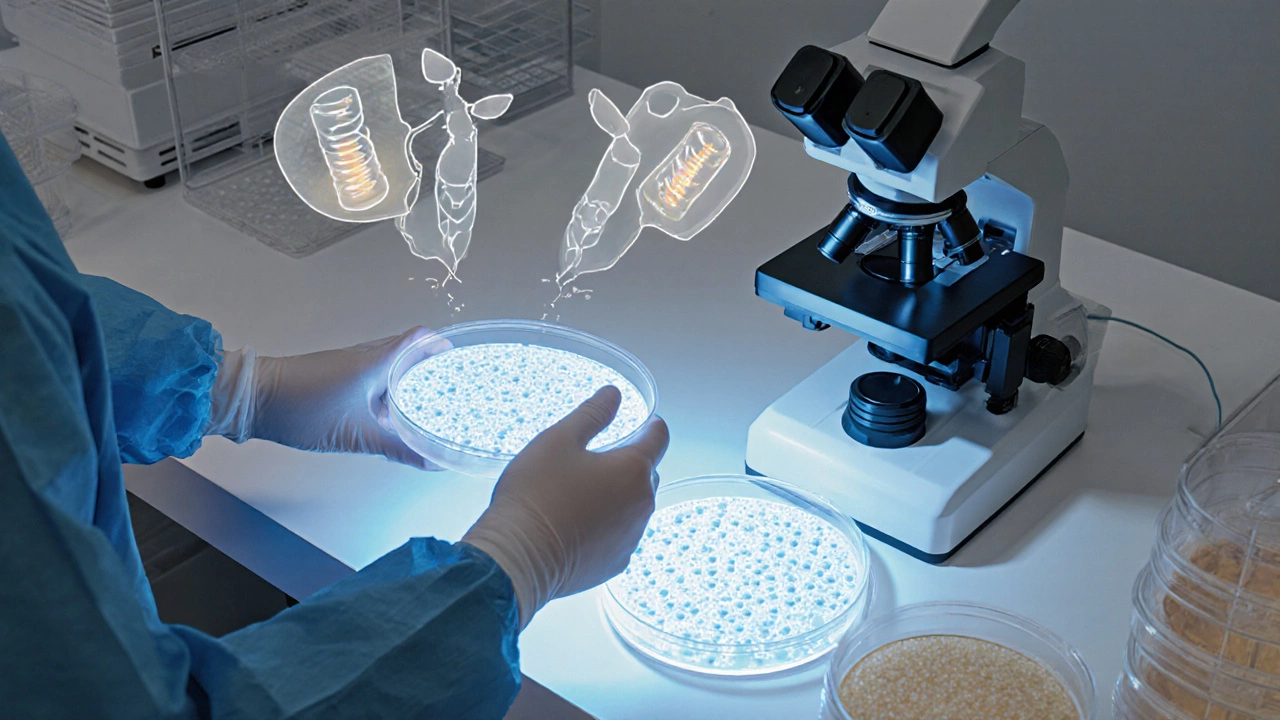IVF Timeline Calculator
Personalize Your IVF Timeline
Enter your details to estimate your IVF journey timeline
How Your IVF Timeline Works
Your journey through IVF consists of several key phases with specific timeframes:
Your Estimated IVF Timeline
Total Duration
Key Phases
Consultation:
Stimulation:
Egg Retrieval:
Embryo Culture:
Transfer:
Two-Week Wait:
Factors Affecting Your Timeline
- Age 3-4 days
- Ovarian Reserve 2-5 days
- Protocol Type 1-2 days
- Cycle Type 2-3 weeks
When you start an in‑vitro fertilisation journey, the biggest question on everyone’s mind is timing - IVF timeline can feel like a mystery wrapped in hormones and appointments. Below is a clear, step‑by‑step walk‑through of the average time from the first clinic visit to that hopeful positive pregnancy test, plus the key factors that can speed it up or stretch it out.
Key Takeaways
- From the first stimulation shot to a pregnancy test, a typical fresh IVF cycle takes 4-6 weeks.
- Frozen‑embryo transfers (FET) add 2-3 weeks after the initial cycle.
- Age, ovarian reserve, and protocol type are the biggest timing influencers.
- Most clinics schedule the first embryo transfer 5‑6 days after egg retrieval.
- If pregnancy isn’t confirmed, a new cycle usually starts after a 2‑week break.
In‑vitro fertilisation (IVF) is a assisted reproductive technology that combines controlled ovarian stimulation, egg retrieval, laboratory fertilisation, embryo culture and transfer to help couples achieve pregnancy. While the scientific steps are consistent worldwide, the exact calendar can vary based on individual health, clinic protocols, and whether you use fresh or frozen embryos.
1. The First Consultation and Baseline Tests (1-2 Weeks)
Everything starts with a thorough evaluation: hormone panels (FSH, AMH, estradiol), an ultrasound to count antral follicles, and sometimes a semen analysis. These tests help the clinic design a personalised stimulation plan. Most patients schedule this visit within a week of deciding to try IVF, and the results are usually back in 5-7 days.
2. Ovarian Stimulation - The Hormone Countdown (7-14 Days)
Ovarian stimulation uses injectable gonadotropins to coax the ovaries into producing multiple mature follicles. Daily injections last about 10‑14 days, depending on how the ovaries respond. Monitoring appointments-blood tests and transvaginal ultrasounds-happen every 2‑3 days to track growth. Patients often notice bloating, mild cramping, or mood swings during this phase.
3. Trigger Shot and Egg Retrieval (Day 0‑1)
When follicles reach the target size (usually 18‑20mm), a “trigger” injection of hCG or a GnRH agonist is given to mature the eggs. Egg retrieval is scheduled roughly 36 hours later and is performed under light sedation. The procedure itself takes about 20‑30 minutes, and most women feel back‑to‑normal by the next day.

4. Laboratory Fertilisation and Embryo Culture (Day 0‑5)
Fertilisation occurs either by conventional insemination or intracytoplasmic sperm injection (ICSI). The resulting embryos are cultured for 3‑5 days. By day3, embryos typically reach the 6‑8 cell stage; by day5, they may become blastocysts-considered the most implantation‑ready form.
5. Fresh Embryo Transfer - The First Chance (Day 5‑6)
Embryo transfer is a quick, painless procedure where one or two embryos are placed into the uterine cavity using a thin catheter. The timing is critical: fresh transfers are usually done 5‑6 days after retrieval, aligning with the natural window when the uterine lining is most receptive.
6. The Two‑Week Wait - Pregnancy Test (Day12‑14 Post‑Transfer)
After transfer, patients wait about 12‑14 days before taking a serum β‑hCG test. A level above 10mIU/mL typically indicates a chemical pregnancy, while a rising curve over the next few days confirms an intrauterine gestation. Positive results bring relief; a negative test leads to planning the next step.
7. Frozen‑Embryo Transfer (FET) - Extending the Timeline (2‑3 Additional Weeks)
If a fresh cycle doesn’t result in pregnancy-or if a clinic prefers to freeze embryos for later use-patients enter the FET pathway. After the eggs are frozen, the uterine lining is prepared with either a natural or hormone‑replacement protocol. The actual transfer then follows the same 5‑6 day embryo culture schedule, adding roughly 2‑3 weeks to the overall timeline.
Typical IVF Calendar at a Glance
| Phase | Fresh Cycle | Frozen‑Embryo Transfer (FET) |
|---|---|---|
| Consultation & tests | 7‑10 days | 7‑10 days (same as fresh) |
| Ovarian stimulation | 10‑14 days | - (already completed) |
| Egg retrieval & fertilisation | 1‑2 days | - (already completed) |
| Embryo culture | 5‑6 days | 5‑6 days (post‑thaw) |
| Transfer | Day5‑6 | Day5‑6 after thaw |
| Pregnancy test | Day12‑14 post‑transfer | Day12‑14 post‑transfer |

Factors That Can Stretch or Shorten the Timeline
- Age: Women over 35 often require a slightly longer stimulation phase to retrieve enough eggs.
- Ovarian reserve: Low AMH may mean fewer follicles, prompting a “mini‑IVF” protocol that can be shorter but less likely to produce multiple embryos.
- Protocol type: Antagonist protocols tend to be a day shorter than long‑agonist protocols.
- Embryo quality: High‑quality blastocysts may be transferred on day5, while poorer embryos sometimes stay to day6 for further assessment.
- Clinic scheduling: Busy centers might space out appointments, adding a few days.
What to Do If the First Cycle Doesn’t Result in Pregnancy
Most doctors recommend a short rest period-usually 2 weeks-to allow hormone levels to normalise before starting a new cycle. During this break, you can review the lab reports, discuss any protocol tweaks, and consider whether to use fresh embryos again or move to a frozen‑embryo approach. Many patients achieve pregnancy on their second or third cycle, especially when they adjust stimulation doses based on the previous response.
Real‑World Example: A Typical Journey for a 32‑Year‑Old
Sarah (32) and her partner began IVF on March1. After a 9‑day stimulation phase, she received the trigger on March10, and egg retrieval took place on March11. Fertilisation and embryo culture ran through March16, and the fresh transfer happened on March17. The β‑hCG test on March31 was positive, confirming pregnancy after just 31 days from the first injection. This timeline aligns with the average 4‑6‑week window for a successful fresh IVF cycle.
Quick Checklist Before Your First Cycle
- Confirm baseline hormone levels and antral follicle count.
- Discuss protocol options (antagonist vs. agonist) with your doctor.
- Arrange a support system for the injection phase.
- Plan for the two‑week wait mentally and logistically.
- Know the date of your expected pregnancy test and have a backup plan if it’s negative.
Frequently Asked Questions
How many weeks does a typical IVF cycle take?
A fresh IVF cycle usually spans 4-6 weeks from the first hormone injection to the pregnancy test. Frozen‑embryo transfers add another 2-3 weeks after the initial cycle.
Can the timeline be shorter for younger patients?
Younger women with a good ovarian reserve often respond quickly to stimulation, sometimes shortening the medication phase by a day or two, but the overall timeline remains close to the 4‑week mark because the lab processes are fixed.
Is the two‑week waiting period always 14 days?
Most clinics schedule the serum β‑hCG test 12‑14 days after transfer. Some doctors may test a day earlier if they use highly sensitive assays, but 14 days is the standard to avoid false‑negative results.
Do frozen‑embryo transfers take longer overall?
Yes. After the first fresh cycle, an FET adds roughly 2‑3 weeks for endometrial preparation and embryo thawing before the transfer, making the total from the original stimulation about 7‑8 weeks.
What should I do if the first IVF attempt fails?
Take a short 2‑week break, review your cycle’s lab results, and discuss protocol tweaks with your specialist. Many couples achieve pregnancy on the second or third cycle, especially when adjustments are made based on the previous response.
